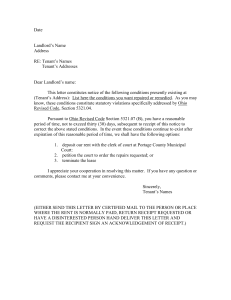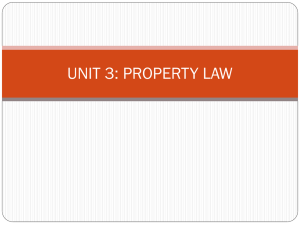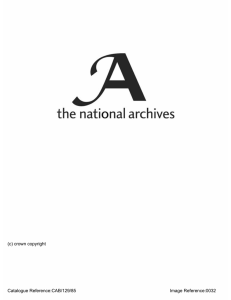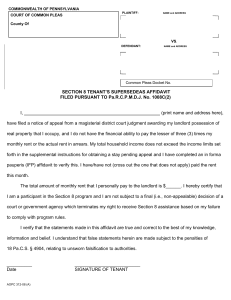LAW & YOU UNIT 3 TEST: Chapters 15-19
advertisement
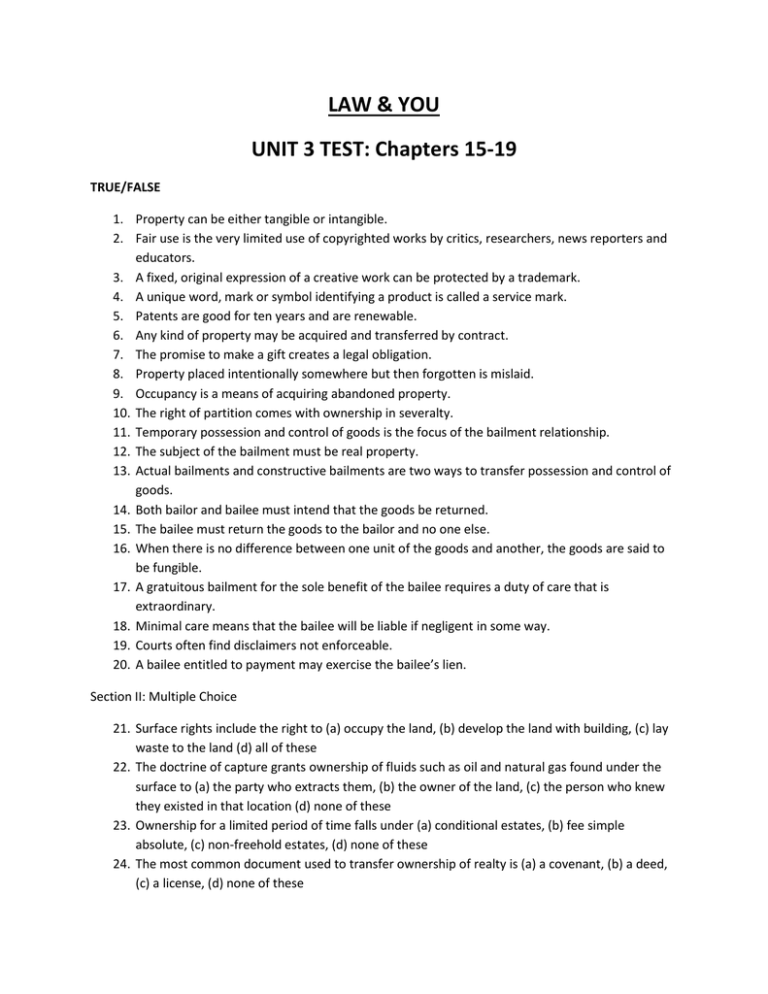
LAW & YOU UNIT 3 TEST: Chapters 15-19 TRUE/FALSE 1. Property can be either tangible or intangible. 2. Fair use is the very limited use of copyrighted works by critics, researchers, news reporters and educators. 3. A fixed, original expression of a creative work can be protected by a trademark. 4. A unique word, mark or symbol identifying a product is called a service mark. 5. Patents are good for ten years and are renewable. 6. Any kind of property may be acquired and transferred by contract. 7. The promise to make a gift creates a legal obligation. 8. Property placed intentionally somewhere but then forgotten is mislaid. 9. Occupancy is a means of acquiring abandoned property. 10. The right of partition comes with ownership in severalty. 11. Temporary possession and control of goods is the focus of the bailment relationship. 12. The subject of the bailment must be real property. 13. Actual bailments and constructive bailments are two ways to transfer possession and control of goods. 14. Both bailor and bailee must intend that the goods be returned. 15. The bailee must return the goods to the bailor and no one else. 16. When there is no difference between one unit of the goods and another, the goods are said to be fungible. 17. A gratuitous bailment for the sole benefit of the bailee requires a duty of care that is extraordinary. 18. Minimal care means that the bailee will be liable if negligent in some way. 19. Courts often find disclaimers not enforceable. 20. A bailee entitled to payment may exercise the bailee’s lien. Section II: Multiple Choice 21. Surface rights include the right to (a) occupy the land, (b) develop the land with building, (c) lay waste to the land (d) all of these 22. The doctrine of capture grants ownership of fluids such as oil and natural gas found under the surface to (a) the party who extracts them, (b) the owner of the land, (c) the person who knew they existed in that location (d) none of these 23. Ownership for a limited period of time falls under (a) conditional estates, (b) fee simple absolute, (c) non-freehold estates, (d) none of these 24. The most common document used to transfer ownership of realty is (a) a covenant, (b) a deed, (c) a license, (d) none of these 25. When adverse possession occurs, (a) the occupation is without the consent of the owner, (b) the occupation is open and notorious, (c) the possession is continuous for several years, (d) all of these 26. Duties of the tenant do NOT include, (a) replacing a roof, (b)paying rent on time, (c) making minor repairs, (d) general maintenance 27. A landlord may evict a tenant (a) if the landlord has a better offer of rent, (b) if the tenant is not staying on the premises even though the rent has been paid, (c)if the tenant has failed to make minor repairs, (d) if the tenant fails to pay their rent 28. The implied warranty of habitability is the responsibility of the (a) Fair Housing Act, (b) landlord, (c) tenant, (d) community. 29. Zoning ordinances (a) restrict the owner’s use of this or her realty, (b) promote the health, safety, morals and general welfare of the community, (c) both a and b, (d) none of these 30. If a tenant fails to pay rent the landlord may (a) sue to evict, (b) throw the tenant out, (c) nothing, (d) none of these 31. When an insurance company makes payment for a loss to suffering party, the insurance company is said to (a) benefit the loss, (b) endorse the loss, (c) indemnify the loss, (d) none of these 32. The stated maximum amount of money that can be pad on an insurance policy is the (a) benefit, (b) endorsement, (c) face value, (d) premium. 33. The type of insurance that covers structural loss due to rain, hail, earthquake, and windstorm is (a) fidelity, (b) fire, (c) inland marine, (d) social 34. The type of insurance that covers automobile, burglary, disability and liability is (a) casualty, (b) fidelity, (c) inland marine, (d) social 35. Insurance providing protection against claims of parties who suffer injury or other loss as a result of negligence committed by the insured is (a) fidelity, (b) inland marine, (c) liability (d) social 36. A fire insurance clause that requires the insured to maintain coverage equal to ta certain percentage of the total current value of the insured property is (a) coninsurance, (b) inland marine, (c) liability (d) social 37. A hostile fire is started by (a) accident or negligence, (b) a deliberate act, (c) friendly fire that becomes uncontrollable, (d) all of these 38. Automobile insurance coverage indemnifying insureds for damage to their own vehicles is (a) collision, (b) comprehensive, (c) not available, (d) both a and b. 39. A life insurance clause prohibiting the insurer from refusing to perform due to misrepresentation or fraud after the policy has been in effect for one or two years is (an endorsement, (b) exclusion, (c) incontestabality clause, (d) omnibus clause 40. The primary source for social insurance coverage in the country is the (a) Federal Insurance Contributions Act, (b) Retirement, Survivor’s Disability Act and Health Insurance Act, (c) Social Security Act, (d) Medicare Act. 41. The maker of a will is called (a)administrator, (b) executor, (c) testator, (d) trustee 42. A court-appointed personal representative overseeing an estate is called (a)administrator, (b) executor, (c) testator, (d) trustee. 43. In most states a person under 18 does not have (a) testamentary capacity, (b) testamentary intent (c) testamentary formality, (d) all of these 44. A will only takes effect (a) upon the death of the maker, (b) upon the witnessed signing of it, (c) upon the official recording of it, (d) upon the one-year anniversary of the death of the maker. 45. If proclaimed during the maker’s last illness or by service personnel on active duty, some states will recognize (a) a codicil, (b) a holographic will, (c) nuncupative will, (d) testamentary trust. 46. When a separate entity under law becomes the transferee of the property, it creates (a) an estate, (b) a codicil, (c) a council, (d) a trust. 47. A trusted created during the lifetime of the settlor is ___ trust (a) charitable (b) inter vivos, (c) spendthrift (d) testamentary 48. The trust that protects the beneficiary’s interest in the subject property from the beneficiary’s creditors is a ____ trust (a) charitable, (b) inter vivos, (c) spendthrift (d) testamentary 49. A constructive trust is a type of ___ trust (a) charitable, (b) express, (c) implied, (d) private. 50. The clear intention to make a will without undue influence of others is called (a) testamentary capacity, (b) testamentary intent, (c) testamentary formality, (d) all of these Cases – analyze each case and provide a descriptive response using terms from the unit in your response. 5 points per case. 51. Kurt & his best friend bought a motorcycle together and as friends they decided to co-own the bike as joint tenants. Years later Kurt married and in his will he stated that all personal property should go to his wife. While driving to work Kurt crossed railroad tracks and was killed in his car. Who owns Kurt’s interest in the motorcycle and why? 52. The city of Johnston maintained an old-fashioned Merry Go-Round near a beach. All summer both kids and adults would ride it. It was shut down during the winter. Occasionally, kids would climb the fence around the Merry Go-Round, start the electrical motor, and ride it for free. Shelly, age 12, climbed the fence, started the motor, but had her hand crushed when it was caught between the v-belt and a pulley on the motor. Is the city of Johnston liable to Shelly and if so, why? 53. Erica drove her car into a self-parking lot at the Lambert Airport in St. Louis. She entered through an automatic gate and received a ticket bearing the date and time of arrival. She parked, locked the car, and left with the keys. Normally, when ready to depart, she would drive her car to the exit, give the ticket to the attendant and pay her parking fee. This time the car had been stolen. Erica sued the defendant, Airport Parking Company of St. Louis, for damages. Is the defendant liable? Why or why not? 54. John had a considerable amount of wealth in his estate and he had three children & a wife whom he loved dearly. John did not want to show favoritism in the distribution of his estate upon death so he did not make up a will. Explain what will happen to his estate and if this decision was a good idea financially by him.
